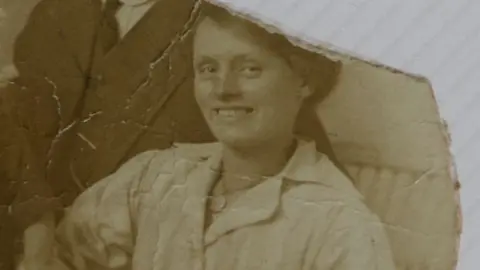Print in 1967 murder case matches accused, jury told
 PA Media/Elizabeth Cook
PA Media/Elizabeth CookExperts called upon as part of a murder trial have told a court the 92-year-old defendant's palm prints match those found at the crime scene in 1967.
Ryland Headley is accused of forcing entry into the Bristol home of Louisa Dunne, 75, before sexually attacking and fatally strangling her.
Despite recovering a palm print on a rear window of the Easton property and collecting thousands of prints from men and boys, detectives were unable to identify a suspect at the time.
Mr Headley, of Clarence Road in Ipswich, denies raping and murdering Mrs Dunne.
Police launched an investigation after the mother-of-two's body was discovered by neighbours on the morning of 28 June 1967.
It was only during a cold case review last year that convicted rapist Mr Headley was identified as a suspect, Bristol Crown Court was told.
Following his arrest, fingerprint experts compared his palm print to the one recovered from Mrs Dunne's window.
Elizabeth Hobbs told the court she found "13 characteristics in agreement" between the two prints, which satisfied her it was a positive match.
Jeremy Benson KC, representing Mr Headley, asked: "What I am going to suggest is that you made a mistake?"
She replied: "I disagree. This is an identification of the left palm in the fingerprint form of Ryland Headley to the crime scene mark."
A second expert then undertook the analysis again with no knowledge of the case or the earlier findings.
That expert, Neville Williams, found he was able to "exclude" Mr Headley from his blind verification exercise, the court heard.
 PA Media
PA MediaDue to the difference in opinions, Mr Williams re-examined his work having discussed his findings with Ms Hobbs, the jury was told.
"She showed me where she found her first two matching characteristics, and it was then that I realised that I'd been starting in a different area of the palm," he said.
"Now that I had what I refer to as a jumping off point, I was then able to make more points of comparison, find more ridge characteristics in a coincident sequence," he told Bristol Crown Court.
Mr Williams said he found 19 characteristics between the two palm prints.
"At which point I stopped my comparison work because I was confident in my evaluation that there was in fact an identification to the palm on the fingerprint form," he said.
He told the court his colleague "didn't assist in any way shape or form", simply giving the "two starting points".
 PA Media
PA MediaMr Benson questioned the witness about his first conclusion, suggesting it was a "little embarrassing" he and Ms Hobbs had reached different conclusions.
"No embarrassment was involved at all," Mr Williams replied, adding he was "100% confident" with his final findings and had started in the wrong area of the palm on the initial assessment.
"I'm going to suggest that actually the prints were inconclusive," argued Mr Benson.
The expert replied: "I did not come to the result inconclusive on my second examination."
The court heard a third expert undertook the same exercise and concluded the palm print matched Mr Headley.
Jurors were previously told advances in forensic science enabled samples recovered from Mrs Dunne's body to be tested for DNA, which were a billion-to-one match to the defendant.
The trial was adjourned until Monday.
Follow BBC Bristol on Facebook, X and Instagram. Send your story ideas to us on email or via WhatsApp on 0800 313 4630.
